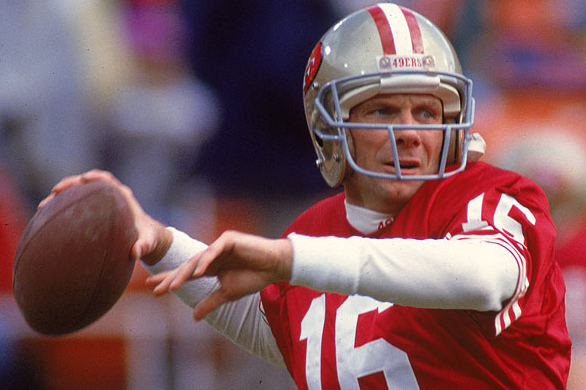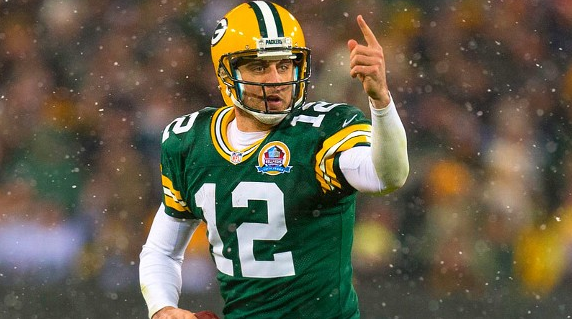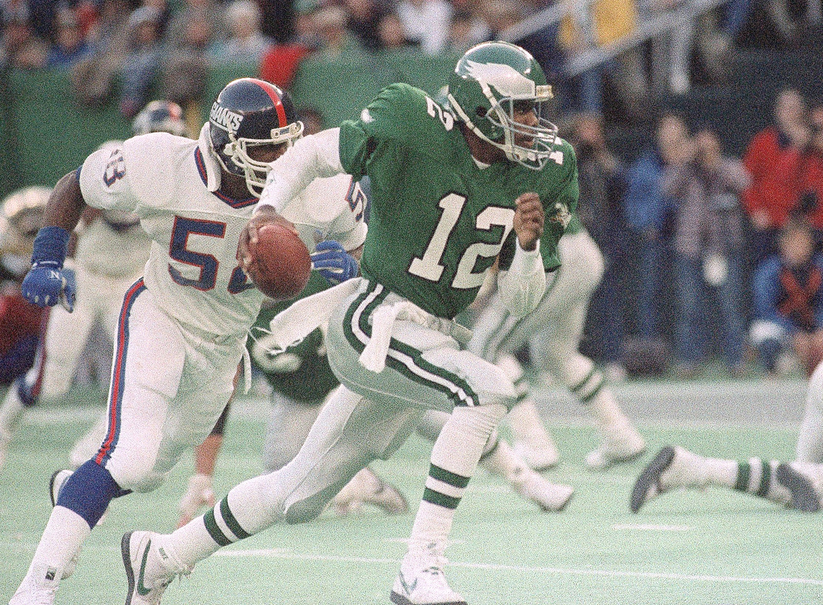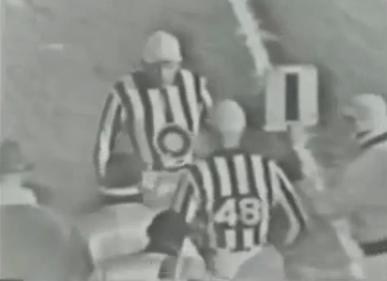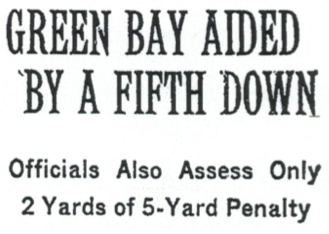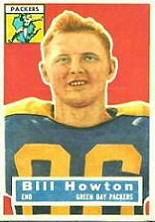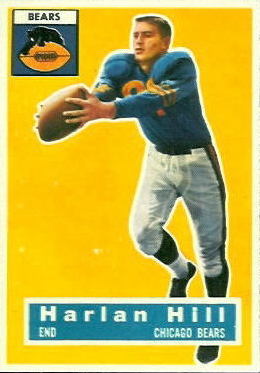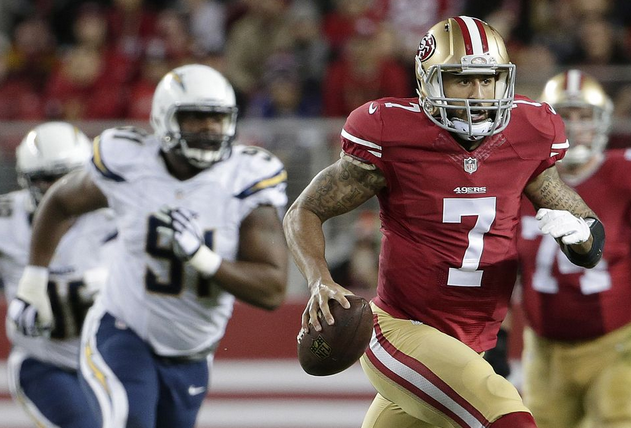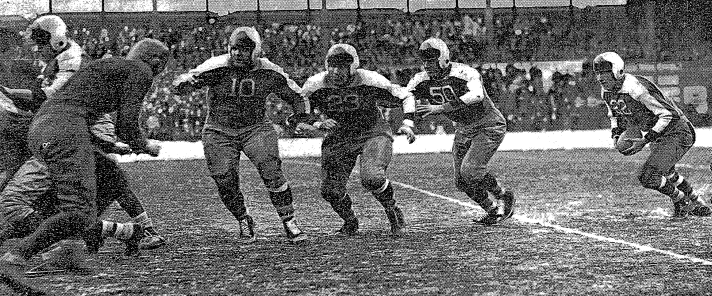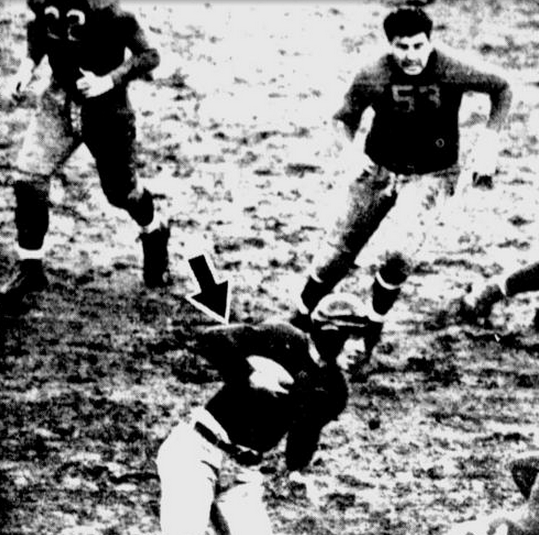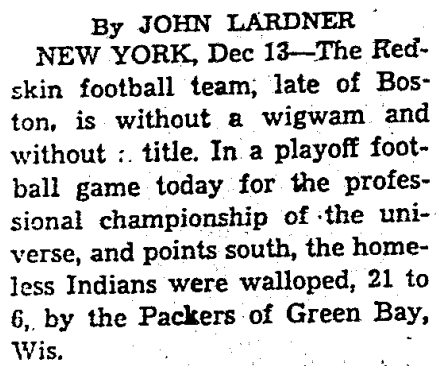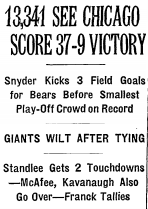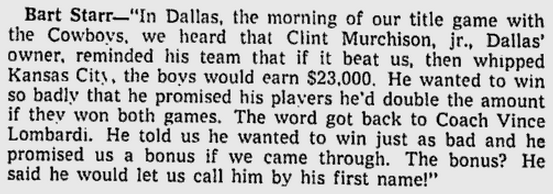With the Packers and Cowboys cracking helmets Sunday – their first postseason meeting at Lambeau Field since the legendary 1967 Ice Bowl – it seemed like a good time to revisit the most famous play from that game, Bart Starr’s quarterback sneak that won it.
There was no discussion of a [subsequent] fourth-down play or possible field-goal try. That’s testimony either to Lombardi’s supreme confidence or the effect the cold was having on his brain.
By Bob O’Donnell (from The Pro Football Chronicle)
If one play has come to symbolize Vince Lombardi’s great Green Bay Packers teams, it’s Bart Starr’s quarterback sneak that won the 1967 Ice Bowl. Remember?
Sixteen seconds left. Dallas ahead 17-14. Temperature: minus 19. Guard Jerry Kramer drives the Cowboys’ Jethro Pugh out of the hole, and Starr falls behind him into the end zone for the winning score. It’s one of pro football’s golden moments.
What you don’t hear about Starr’s sneak is that (1) it was a lousy call, (2) Kramer was offside and (3) Packers center Ken Bowman should have shared the credit for the famous block.
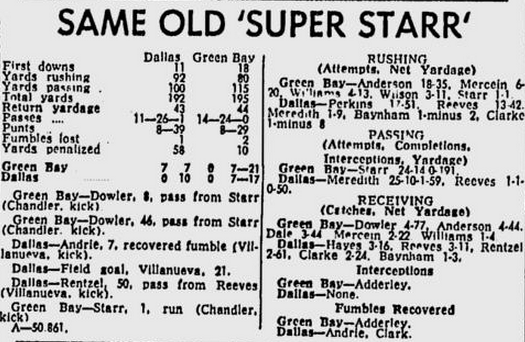 Let’s start with the play itself. It was an outrageous gamble, really. Cowboys assistant coach Ermal Allen muttered afterward: “I just wish it had failed. You think there wouldn’t have been a few million words written about that? Then we’d see how smart [Lombardi] felt.”
Let’s start with the play itself. It was an outrageous gamble, really. Cowboys assistant coach Ermal Allen muttered afterward: “I just wish it had failed. You think there wouldn’t have been a few million words written about that? Then we’d see how smart [Lombardi] felt.”
Allen was right, if a little bitter. The Packers had the ball two feet from the Dallas goal line, third down. They were out of timeouts. Had the sneak been stopped, the Packers wouldn’t have had time to attempt the tying field goal or any way to stop the clock. The Cowboys would have been the 1967 NFL champions, and the legendary Lombardi would have been second-guessed for centuries.
“We thought they would throw,” then-Dallas coach Tom Landry says. “We thought they probably would go on an option, a rollout run or pass so they could stop the clock [with an incompletion] if it didn’t work.”
So did most people. It was the percentage move.
The sneak was Starr’s idea. On the two plays preceding it, halfback Donny Anderson slipped taking the handoff and was stopped for almost no gain. The south end of Green Bay’s Lambeau Field lay in the shadow of a large scoreboard and was frozen solid. When Anderson slipped a second time, Starr decided the Packers’ best shot was for him to keep the ball.
He called the team’s final timeout. Before coming to the sideline to meet with Lombardi, he asked Kramer and Bowman if they could get enough footing to run 31 Wedge. They said they could. The play was a simple dive right. The guard and center double-teamed the defensive tackle, and the quarterback handed off to a back running straight ahead.
“I told Coach Lombardi there was nothing wrong with the plays we had run, it’s just that the backs couldn’t get any footing,” Starr says. “I said, ‘Why don’t I just keep it?’ All he said was run it and let’s get the hell out of here. That’s all he said.”
There was no discussion of a fourth-down play or possible field-goal try. That’s testimony either to Lombardi’s supreme confidence or the effect the cold was having on his brain. What made the call even more unusual was that Starr rarely ran the sneak. He could recall doing it on only one other occasion, a few years earlier against the 49ers. Sleet had turned the field to ice, and the footing was terrible that day, too. Nonetheless, he had scored.
“I still don’t think it was a smart play,” says Cowboys halfback Dan Reeves, now the Denver Broncos’ coach. “But maybe that’s the reason Lombardi won all those championships and I haven’t won any.”
Packers fullback Chuck Mercein looks at it this way: “Bad is only bad if it doesn’t work. To me, success justifies a lot of questionable calls.”
Of course, it always helps if your right guard can beat the snap count. A fraction of a second before Bowman hiked the ball to Starr, Kramer picked up his hand and started out of his three-point stance. You can’t imagine what a comfort that knowledge is to Pugh.
In December 1967, he was in his third year in the NFL. He played 11 more and never shed the label as The Guy Who Got Blocked On Starr’s Sneak. For years after the Ice Bowl, he carried 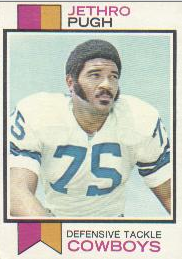 inside him this image of Kramer moving before the snap. The Cowboys never bothered to watch the game films, so he kept it to himself. It sounded like the cheapest kind of excuse.
inside him this image of Kramer moving before the snap. The Cowboys never bothered to watch the game films, so he kept it to himself. It sounded like the cheapest kind of excuse.
“In a goal-line situation like that you key the football,” Pugh says. “And I could visualize Kramer’s hand moving an instant before the ball did. My first thought [after the play] was, ‘We got ’em . He’s offsides, and that’ll cost ’em five yards.’ I was shocked when I didn’t see a flag. I kept looking around for one.”
Four times in the ’70s Pugh’s Cowboys went to the Super Bowl. Reporters never failed to bring up the play. He answered their questions but kept the little picture of Kramer moving a split second early to himself. Years later, he finally had an opportunity to see the game films and watched with a combination of curiosity and anxiety.
“I saw it, and I said, ‘My goodness, I was right,’ “ Pugh says.
Even Kramer doesn’t deny it. In his 1968 best seller, Instant Replay, he says: “I wouldn’t swear that I didn’t beat the center’s snap by a fraction of a second. I wouldn’t swear that I wasn’t actually offside on the play.”
The block made him famous. The networks showed the play over and over in the days after the game, and Kramer didn’t hesitate to take credit. He became America’s Guard. Every football fan knew him and his block — and soon, his book.
Largely overlooked was Bowman’s contribution. Pugh lined up on Kramer’s inside shoulder on the play, and his instructions were to stay low and clog the middle so linebacker Lee Roy Jordan could make the tackle. It was Kramer’s job to raise Pugh up so Bowman could get a clean shot at him. Together, the two could then drive the Cowboys tackle out of the hole. That was precisely what happened on the play, and it still rankles Bowman that Kramer got almost all the glory.
“The older I get, the more it bothers me,” he says. “I was young [a fourth-year pro] and stupid, and he patted me on the shoulder as he went up to the [television] podium after the game and said, ‘Let an old man have his moment in the spotlight. You’ve got 10, 12 more years.’
“What I didn’t realize was that blocks like that come along once in . . . hell, it’s been two decades now.”
Says Kramer: “My feeling is that I don’t know how much he contributed. I did say to him, ‘You tell them about what you did because you’ve got a few more years. I’m talking about what I did.’ ”
Pugh sides with Bowman. “Kramer had good position, but Bowman did more of the blocking,” he says.
All this was lost in the strange beauty and confusion of the moment. As the Packers broke the huddle and came to the line of scrimmage, the 50,000 frigid fans started to cheer. There hadn’t been much opportunity for that since early in the game.
The Cowboys had dominated the second half and appeared on their way to winning until the Packers put together their final, improbable drive. Now a third straight NFL title for Green Bay was 24 inches away.
The sun was sinking. The wind chill factor was minus 50. Many of the fans were dressed in brightly colored hunting gear, and Green Bay assistant coach Phil Bengtson said the effect was that of a red halo around the field. Breath poured from them like smoke from chimneys.
Pugh tried to dig himself a foothold in the frozen turf, but his toes were numb. He gave up and took his position. So did the Packers. The crowd hushed. Bowman snapped the ball, and before Pugh could get out of his stance, Kramer was on him. Then Bowman was, too, and Pugh slid helplessly out of the way. Starr took a step to his right, then slipped into the fast-closing opening. Touchdown.


